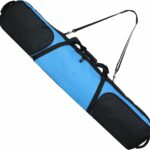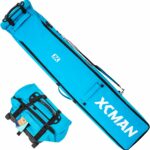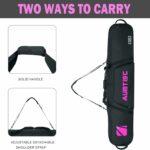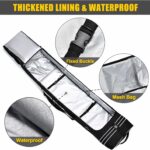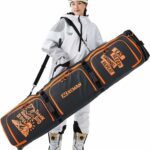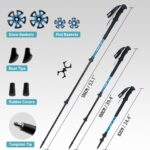You’re embarking on a snowboarding adventure and you’ve got everything you need – a crisp mountain view, the perfect weather, and an impressive set of gear. But then it hits you, is your snowboard the right size? “How Long Should Your Snowboard Be?” is an article designed to address this exact question that many snowboarding enthusiasts, including yourself, often grapple with. It provides detailed information and an insightful guide to help you find the perfect snowboard length for your height, weight, riding style, and skill level. By the end of this article, you’ll know exactly what size of board will have you gliding down those slopes like a pro.
Importance of Snowboard Length
When it comes to snowboarding, the length of your snowboard plays a crucial role in your overall performance. It might seem like the length of a snowboard is negligible; after all, it’s just a board for sliding down the slope, right? Well, not exactly. The right length can enhance your speed, balance and maneuverability.
Significance of the Right Length
The length of your snowboard can significantly influence your riding experience. A board with the right length allows better control and maneuverability on the snow, making your rides smoother, safer, and more enjoyable. If it’s too long or too short, you may struggle with control and balance, making the ride less efficient and potentially threatening your safety.
Impacts of Incorrect Snowboard Length
The consequences of using a snowboard of incorrect length can be far-reaching. You could face issues with turning and maneuverability, as a board that’s too long can be difficult to control, while a board that’s too short could lack stability. Such issues can lead to falls, accidents, and injuries, particularly if you’re snowboarding at high speeds or in challenging terrain.
General Guidelines for Selecting Snowboard Length
Selecting the right snowboard length involves various factors. Usually, height and weight are the primary considerations, but there’s also the physics of how the board interacts with snow.
Relation of Snowboard Length with Height and Weight
Generally, your snowboard length should correspond with your height and weight. If you’re taller or heavier, a longer board will offer better support and stability. Conversely, if you’re shorter or lighter, a shorter board should suffice.
Physics Behind Snowboard Length
The physics that justify the correspondence of weight, height and board length are fairly simple. With a longer board, there’s more surface area in contact with the snow. This not only results in enhanced stability but also allows faster speeds as there’s less friction. Conversely, a shorter board has less surface area in contact with the snow – while it might be less stable and slower, it’s typically easier to maneuver and control.
Snowboard Length for Beginners
For beginners, comfort should be the main priority when selecting the snowboard length.
Suggestive Lengths for First-Time Riders
As a first-time rider, choosing a shorter snowboard may make your initial experiences more enjoyable. Shorter boards are easier to maneuver – an essential feature for beginners trying to gain balance and control on the slopes. Once you grow more comfortable and confident on the snow, you can then consider moving to a longer board for better stability and speed.
Importance of Comfort in the Initial Stages of Learning
Being comfortable on your snowboard in the initial stages of learning is of utmost importance. A shorter board generally offers this comfort, as it can be easier to control. This can boost your confidence substantially, making your initial experiences on the snow more pleasant.
Snowboard Length for Intermediates
Intermediate riders should opt for snowboard lengths that cater to their specific requirements.
Recommended Lengths for Intermediate Snowboarders
As an intermediate snowboarder, you can consider choosing a board length between the chin and nose. This length offers a balance of maneuverability and stability, which is crucial as you explore different terrains and improve your skills.
Benefits of Customizing Length as per Specific Requirements
Customizing your snowboard length is beneficial as you transition from a beginner to an intermediate rider. Depending on the type of snowboarding you’re pursuing or the terrain you’re on, your snowboard length can drastically influence your ride.
Snowboard Length for Advanced Riders
For advanced riders, a longer snowboard can provide better stability and control – two essentials for advanced freeriding.
Extra Length for Better Stability
As an advanced rider, you likely ride at high speeds and on more challenging terrains. In such cases, a longer snowboard can provide the extra stability required to maneuver safely and efficiently.
Importance of Control for Advanced Freeriding
Advanced freeriding necessitates excellent control, which is where a longer snowboard comes in handy. With more surface area in contact with the snow, a longer snowboard can provide higher speeds and a smoother ride.
Snowboard Length for Kids
For kids, safety and potential for growth should be major considerations when selecting snowboard length.
Maximizing Safety with Correct Snowboard Length
Choosing the right snowboard length for kids is a critical safety measure. A board that’s too long can be hard for kids to control, increasing the risk of falls and accidents. On the other hand, a board that’s too short might not provide enough stability, which could also lead to accidents.
Considerations for Growth and Skill Advancement
When selecting a snowboard for kids, it’s necessary to consider not just their current height and weight, but also their potential for growth and development. With kids growing quickly, a board that’s slightly longer could be a wise investment as it could last more than just one season. Optimally, the board’s length should still allow for proper control and maneuverability.
Different Snowboarding Styles and their Influence on Snowboard Length
Your snowboarding style also dictates the length of your board.
Freestyle Snowboarding and Shorter Boards
Freestyle snowboarding requires a lot of jumps, tricks, and maneuvers. For this style, a shorter board is highly recommended as it offers greater control and flexibility – two necessities for performing tricks efficiently.
Backcountry Snowboarding and Longer Boards
On the other hand, backcountry snowboarding involves navigating deep snow and steep slopes. Opting for a longer board in such cases provides the stability and control required to conquer these challenging terrains.
Effect of Terrain on Choosing Snowboard Length
The terrain on which you’ll be snowboarding also affects your choice of board length.
Shorter Boards for Parks and Playful Terrain
If you’re planning to spend your time in snow parks or on playful terrains, a shorter board can help. These environments demand agility and maneuverability, which shorter boards can offer.
Longer Boards for Steeps and Deep Snow
For steeps and deep snow, longer boards are more efficient. They provide much-needed stability and control on these demanding terrains, making your ride safer and smoother.
Influence of Personal Preference on Snowboard Length
Just like taste in music or food, snowboarding can be greatly influenced by personal preference.
Following one’s Riding Style and Comfort
Your comfort and riding style is paramount when choosing a snowboard length. If a particular length allows you to ride comfortably and caters to your style, it’s likely the right pick for you.
Experimenting with Different Lengths
Experimenting with different lengths can also be advantageous. By trying out various lengths, you can discover what works best for you on different terrains or in various snowboarding styles, refining your choice over time.
Consequences of Using a Wrong Snowboard Length
The impact of using a snowboard of the wrong length can be undesirable.
Difficulties in Turning and Balancing
Using a snowboard that’s not the right length can make turning and balancing challenging, particularly if the board is too long. This can hamper your performance and reduce your enjoyment on the slopes.
Increased Risk of Accidents and Injuries
Moreover, an incorrect snowboard length significantly increases the risk of accidents and injuries. This is because a board that’s too long or too short can adversely affect your balance and control. Being unable to manage your snowboard effectively can lead to more falls and potential injuries.
To wrap things up, remember that while these are general guidelines for choosing a snowboard length, the most critical factor is how comfortable you are with your board. A snowboard that aligns with your height, weight, skill level, style, and terrain preference is likely to deliver an amazing snowboarding experience!
- What Snowboard Bindings Should I Get? - January 23, 2024
- What Size Screws For Snowboard Bindings? - January 23, 2024
- How To Snowmobile On Water? - January 23, 2024





